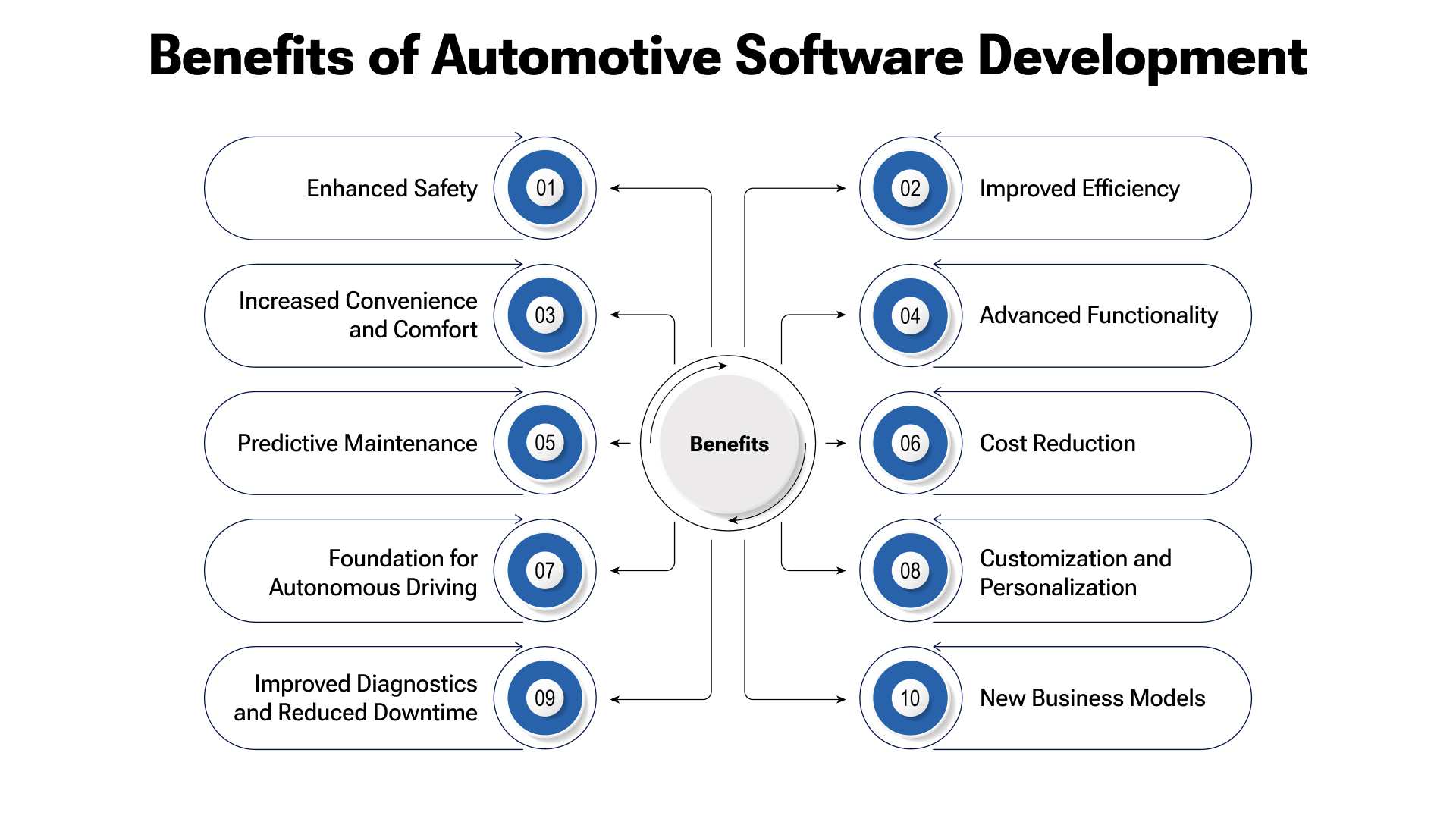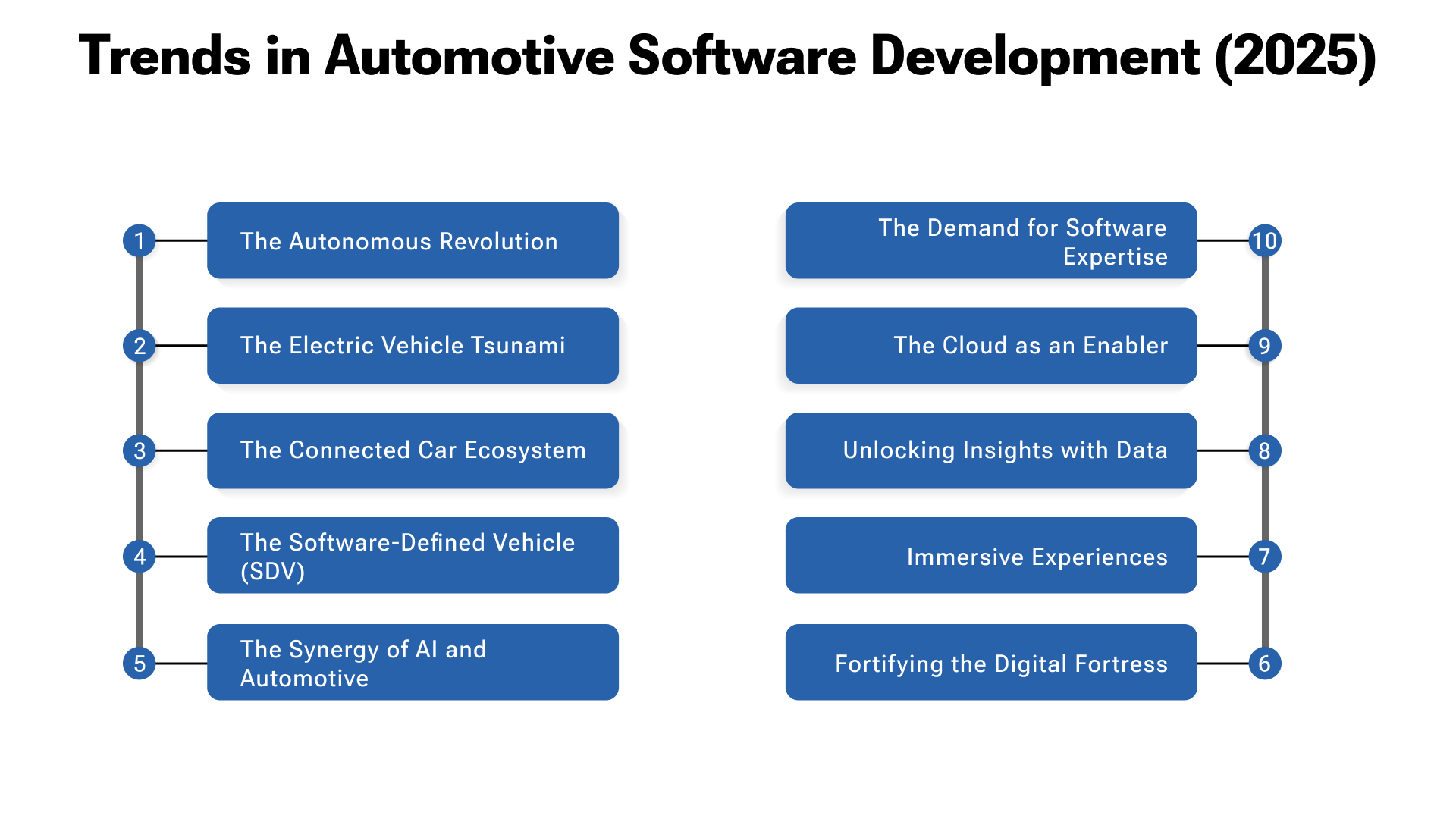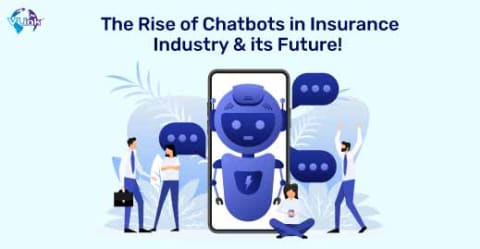The automotive world is in the midst of a seismic shift, transitioning from a mechanical domain to a digital one, where software reigns supreme. Groundbreaking advancements in autonomous driving propel this profound change, as does the electric vehicle revolution and the ever-increasing connectivity of cars.
For startup founders and C-suite executives in the automotive and technology sectors, a deep understanding of the pivotal Trends in automotive software development is not merely advantageous – it's the cornerstone of future success and market leadership.

Automotive software encompasses the vital programmable instructions powering computer-based in-vehicle applications. It forms the backbone of embedded systems and orchestrates functions from basic body control to sophisticated infotainment, telematics, comfort, safety features,
Advanced Driver Assistance Systems (ADAS) and seamless communication applications. Notably, the escalating demand for car-to-car communication is poised to be a significant catalyst for the global automotive software industry's robust growth over the forecast period.
This comprehensive exploration delves into these essential Trends in automotive software development 2025, providing invaluable insights into the technologies, challenges, and burgeoning opportunities that lie on the horizon.
Let’s start!
What is Automotive Software Development?
While the initial definition provides a solid foundation, automotive software development is far more expansive and nuanced than a simple description can convey. It's not just about writing code for cars; it's a multidisciplinary field that intersects with mechanical engineering, electrical engineering, computer science, artificial intelligence, and even user experience design.
At its core, automotive software development is the creation of the digital brains and nervous systems of modern vehicles. Think of it as building the intricate network of instructions that tell every component, from the smallest sensor to the most powerful processor, what to do and how to interact with other parts of the vehicle and the external world.
The Benefits of Automotive Software Development
The integration of sophisticated software into vehicles yields numerous benefits, transforming the automotive landscape:

- Enhanced Safety: Software enables the implementation of crucial safety features like automatic emergency braking, lane departure warning, and adaptive cruise control, significantly reducing the risk of accidents and protecting occupants.
- Improved Efficiency: Software optimizes engine performance, manages fuel consumption in traditional vehicles, and maximizes battery efficiency in electric vehicles, leading to lower operating costs and a reduced environmental impact.
- Increased Convenience and Comfort: Software-powered infotainment systems provide navigation, entertainment, and seamless connectivity, enhancing the overall driving experience for both drivers and passengers. Personalized settings and user interfaces further contribute to comfort and convenience.
- Advanced Functionality: Software drives innovation, enabling features like over-the-air (OTA) updates for continuous improvement, remote diagnostics for proactive maintenance, and sophisticated connectivity with external devices and services.
- Predictive Maintenance: By analyzing real-time data from vehicle sensors, software can predict potential malfunctions and alert drivers to schedule maintenance proactively, preventing breakdowns and ensuring vehicle longevity.
- Cost Reduction: Efficient software can optimize logistics for fleet management, identify fuel-wasting behaviors, and streamline diagnostic processes, leading to significant cost savings for businesses and individuals.
- Foundation for Autonomous Driving: Developing complex algorithms and sensor fusion technologies through software is the bedrock of autonomous vehicles, promising a future of safer, more efficient, and accessible transportation.
- Customization and Personalization: Software allows for a high degree of customization, enabling drivers to tailor vehicle settings, preferences, and even performance characteristics to their individual needs and tastes.
- Improved Diagnostics and Reduced Downtime: Software facilitates quicker and more accurate identification of technical issues, reducing vehicles' time in repair shops and minimizing owners' inconvenience.
- New Business Models: Software enables new services and revenue streams, such as subscription-based features, mobility-as-a-service (MaaS) offerings, and enhanced connectivity services.
Looking ahead to 2025, the pace of innovation in automotive software development shows no signs of slowing down. Now, let's explore the top 10 key trends that will shape the future of our vehicles.
Top 10 Trends in Automotive Software Development
The automotive landscape is undergoing a profound transformation driven by software innovation. These are the key areas shaping the future of vehicle development:

1. The Autonomous Revolution: Software Taking the Wheel
The vision of fully autonomous driving cars is rapidly materializing, with intricate software acting as the central nervous system. This evolution transcends enabling vehicles to navigate independently; it involves crafting sophisticated systems capable of perceiving, interpreting, and reacting to intricate real-world scenarios with unprecedented accuracy and safety.
- AI and Machine Learning as the Engine of Autonomy: The remarkable progress in AI in self-driving cars and the broader application of AI/ML in self-driving cars are the fundamental drivers of autonomous capabilities. AI/ML in self-driving cars algorithms, trained on massive datasets of sensor inputs (LiDAR, radar, cameras), empower vehicles to identify objects, anticipate their behavior, and execute informed driving decisions. Deep learning methodologies continuously refine the precision and resilience of these systems, propelling us towards realizing Level 4 and Level 5 autonomy.
- Sensor Fusion and Real-Time Data Processing: Achieving autonomous operation hinges on the synergistic integration of data from many sensors, each offering a unique perspective of the surrounding environment. The intelligent fusion of this data, processed by high-performance onboard computers running complex software, is paramount for constructing a comprehensive and dependable understanding of the vehicle's context. Efficient algorithms and robust software architectures are indispensable for managing the sheer volume of data in real-time.
- Intelligent Path Planning and Control Systems: Once the environmental context is established, sophisticated path planning software determines the optimal trajectory for the vehicle, prioritizing safety, efficiency, and passenger comfort. Subsequently, control systems translate these plans into precise commands for the vehicle's actuators (steering, braking, acceleration). The reliability and responsiveness of this software are non-negotiable for ensuring secure autonomous operation.
2. The Electric Vehicle Tsunami: Software Powering the Transition
The global imperative for sustainability is fueling the rapid electrification of cars. This transition extends beyond merely substituting internal combustion engines with batteries; it fundamentally restructures the vehicle's architecture and introduces a new layer of software complexity.
- Specialized Electric Vehicle Software Development: The electric vehicle software development domain is experiencing exponential growth. This encompasses the development of sophisticated Battery Management Systems (BMS), which are critical for ensuring the battery pack's safety, performance, and longevity. BMS software monitors cell voltage, temperature, and current, optimizing charging and discharging processes.
- Comprehensive Electric Vehicle Management Software: Beyond the BMS, comprehensive electric vehicle management software is essential for orchestrating the powertrain, managing energy consumption, optimizing charging schedules, and seamlessly integrating with charging infrastructure. This software plays a pivotal role in maximizing the efficiency and enhancing the user experience of EVs.
- Smart Grid Integration through Software: As EV adoption accelerates, their intelligent integration with smart grids becomes increasingly vital. Software solutions are being developed to facilitate bidirectional charging, enabling EVs to draw power from the grid and supply it back, contributing to grid stability and potentially offering economic advantages to EV owners.
3. The Connected Car Ecosystem: Software as the Central Nervous System
Modern vehicles evolve into highly connected platforms, serving as mobile hubs for information, communication, and entertainment. This trend, encapsulated by connected car trends, relies heavily on advanced software and robust network infrastructure.
- Vehicle-to-Everything (V2X) Communication Software: Vehicle-to-everything communication encompasses a spectrum of data exchange modalities, including vehicle-to-vehicle (V2V), vehicle-to-infrastructure (V2I), vehicle-to-pedestrian (V2P), and vehicle-to-network (V2N). Sophisticated software protocols and applications enable seamless and secure communication between vehicles and their surroundings, paving the way for enhanced safety, improved traffic flow, and enriched infotainment services.
- Revolutionizing Updates with Over-the-Air (OTA) Technology: Over-the-air updates fundamentally change how vehicle software is maintained and enhanced. Instead of requiring physical dealership visits, OTA updates empower manufacturers to deploy new features, critical security patches, and performance improvements remotely. This provides unparalleled convenience for owners and facilitates continuous improvement and the delivery of novel functionalities throughout the vehicle's lifecycle.
- Infotainment and the Software-Driven Digital Cockpit: The in-car experience is increasingly defined by sophisticated infotainment systems and digital cockpits powered by advanced software. These interfaces provide navigation, entertainment, communication, and comprehensive vehicle control functionalities. Integrating AI-driven cars with AI-powered virtual assistants and personalized user experiences further elevates these systems' appeal and usability.
4. The Software-Defined Vehicle (SDV): A Paradigm Shift in Automotive Architecture
The software-defined vehicle (SDV) concept represents a transformative shift in automotive architecture. In an SDV, software is dominant in defining the vehicle's features, functionalities, and performance characteristics.
- The Efficiency of Centralized Compute Architectures: The SDV relies on Centralized Compute Architectures in cars, where powerful central processing units (CPUs) and graphics processing units (GPUs) consolidate the computational workload that was previously distributed across numerous electronic control units (ECUs). This centralization streamlines software development, reduces system complexity, and facilitates more seamless integration of diverse vehicle systems.
- Abstraction Layers and Standardized APIs: To effectively manage the SDV's inherent complexity, abstraction layers and standardized application programming interfaces (APIs) are crucial. These enable software development service provider companies and in-house teams to interact with vehicle hardware and functionalities without needing to delve into the intricate details of each underlying component. This fosters innovation and empowers third-party developers to create novel vehicle applications and services.
- Unlocking Functionality with Feature on Demand (FoD): The SDV architecture enables Feature on Demand, allowing owners to purchase and activate new features and functionalities after the initial vehicle acquisition. This unlocks new revenue streams for manufacturers and provides consumers greater flexibility and customization options.
5. The Synergy of AI and Automotive: Intelligent Mobility Redefined
AI-driven cars are no longer a distant vision. Artificial intelligence is seamlessly integrated into virtually every facet of automotive software, enhancing safety, efficiency, and the overall driving experience.
- Elevating Safety with Advanced Driver-Assistance Systems (ADAS): AI-driven cars leverage AI algorithms at the core of advanced driver-assistance systems (ADAS) such as adaptive cruise control, lane-keeping assist, automatic emergency braking, and blind-spot detection. These systems utilize sensor data and sophisticated AI models to perceive the environment, make predictions, and assist the driver in various driving tasks, ultimately bolstering safety and reducing driver fatigue.
- Crafting Personalized Driving Experiences with AI: AI can analyze driver behavior, preferences, and emotional states to curate personalized driving experiences. This includes dynamically adjusting cabin settings, recommending optimal routes, providing tailored infotainment content, and adapting driving dynamics to individual preferences.
- Proactive Maintenance through Predictive Analytics: AI and machine learning algorithms can analyze vehicle sensor data to anticipate potential maintenance issues before they escalate. This proactive approach minimizes downtime, reduces maintenance costs, and enhances vehicle reliability.
6. Fortifying the Digital Fortress: Cybersecurity in the Automotive Landscape
As vehicles become increasingly connected and reliant on software, a robust car Cybersecurity system becomes paramount. Safeguarding vehicles from cyber threats is essential for ensuring their and their occupants' safety and security.
- Implementing End-to-End Security Measures: A comprehensive cybersecurity strategy for vehicles necessitates implementing robust security measures at every layer, from the vehicle's hardware and software to the communication networks and cloud infrastructure it interacts with. This includes secure boot processes, sophisticated intrusion detection and prevention systems, and robust data encryption protocols.
- Advanced Threat Detection and Rapid Response: Sophisticated software is indispensable for continuously monitoring vehicle systems for potential cyber threats, detecting anomalies in real-time, and responding effectively to security incidents. This demands advanced algorithms, real-time analysis capabilities, and the ability to deploy security updates swiftly and efficiently.
- Integrating Security into the Development Lifecycle: The seamless integration of security practices throughout the software development lifecycle, known as DevSecOps in automotive, is crucial for building inherently secure automotive software. This involves embedding security considerations from the initial design phase through development, rigorous testing, and safe deployment.
7. Immersive Experiences: VR and the Metaverse Expanding the In-Car Horizon
While still in their nascent stages, integrating VR in cars and exploring vehicles in the metaverse can revolutionize the in-car experience and even redefine our interaction with cars.
- Transforming In-Car Entertainment with VR: VR could transform long journeys by providing passengers with immersive entertainment experiences, ranging from engaging virtual reality games and captivating movies to simulated travel to distant destinations.
- Enabling Virtual Collaboration and Productivity on the Go: In the future, vehicles could evolve into mobile workspaces, with VR and augmented reality (AR) enabling seamless virtual collaboration and enhanced productivity while commuting.
- Exploring Digital Ownership and Metaverse Experiences: The metaverse could unlock novel ways for users to interact with their vehicles in the digital realm. This could encompass virtual car ownership, participation in immersive virtual driving experiences, and creating personalized digital environments within the vehicle.
8. Unlocking Insights with Data: Automotive Analytics in Self-Driving Cars
The vast troves of data generated by modern vehicles, particularly autonomous driving cars, represent a wealth of information that can be harnessed for diverse purposes. Automotive analytics in self-driving cars is pivotal in extracting valuable insights from this data deluge.
- Refining Autonomous Driving Algorithms with Data-Driven Insights: Data meticulously collected from real-world driving scenarios is indispensable for training and continuously refining the AI/ML in self-driving cars algorithms that power autonomous vehicles. Analyzing this data helps identify challenging edge cases, improve perception accuracy, and enhance decision-making capabilities.
- Optimizing Vehicle Performance and Efficiency through Telematics: Telematics data, diligently gathered in cars, can be analyzed to maximize vehicle performance, improve fuel efficiency (or energy consumption in EVs), and proactively predict maintenance needs.
- Developing Innovative Services and Business Models: Analyzing connected car trends data can yield valuable insights into user behavior, preferences, and mobility patterns, paving the way for developing innovative services and business models, such as personalized insurance offerings, on-demand services, and optimized traffic management solutions.
9. The Cloud as an Enabler: Scalability and Seamless Connectivity
Cloud computing in cars is becoming increasingly indispensable in modern automotive software development and deployment. The cloud provides the essential scalability, seamless connectivity, and immense processing power required to support the complex software systems in today's and tomorrow's vehicles.
- Scalable Data Storage and Processing in the Cloud: The massive volumes of data generated by connected and autonomous vehicles necessitate robust cloud infrastructure for efficient storage, processing, and comprehensive analysis.
- Efficient Software Updates and Deployment via the Cloud: Over-the-air updates and the seamless deployment of new software features are often managed through sophisticated cloud platforms, ensuring efficient and reliable delivery to vehicles in the field.
- Remote Diagnostics and Feature-Rich Telematics Services: Cloud connectivity enables remote vehicle diagnostics, comprehensive telematics services, and the seamless delivery of a wide array of connected car trends applications.
10. The Growing Demand for Software Expertise: Partnering for Future Innovation
As the automotive industry wholeheartedly embraces software-driven innovation, the demand for highly skilled software developers and specialized services is experiencing an unprecedented surge. This presents significant opportunities for established software development service provider companies and those offering bespoke custom software development services tailored to the automotive sector.
- Specialized Skill Sets for Automotive Software: Automotive software development demands expertise in critical areas such as embedded systems, real-time operating systems, AI/ML in self-driving cars, robust car Cybersecurity systems, and scalable cloud computing in cars.
- Agile Development Methodologies for Rapid Innovation: To keep pace with the rapid advancements in the automotive landscape, automotive software development teams are increasingly adopting agile methodologies, enabling faster iteration cycles and more flexible development processes.
- Strategic Collaboration and Partnerships for Accelerated Growth: Automotive OEMs and Tier 1 suppliers are increasingly forging strategic collaborations with specialized software development service provider companies to access the necessary expertise and accelerate their software development initiatives.
The realm of automotive software development is dynamic and multifaceted, presenting exciting opportunities and complex challenges. The above trends underscore a significant shift towards increasingly intelligent, connected, safe, and personalized vehicles. As software permeates every aspect of the automobile, the industry will need a skilled and adaptable workforce capable of navigating this evolving landscape.

Choose VLink's Expertise for Automotive Software Development
In the rapidly evolving landscape of automotive software development, selecting the right partner is paramount to achieving innovation, efficiency, and market leadership.
VLink is a trusted and experienced provider of comprehensive custom software development services tailored to the automotive industry. With a deep understanding of the critical trends in automotive software development 2025, including the intricacies of autonomous driving cars, the nuances of electric vehicle software, and the complexities of connected car trends and car Cybersecurity systems, VLink offers the expertise and agility needed to navigate this dynamic sector.
Our highly skilled engineers and domain experts have a proven track record in delivering cutting-edge solutions across the entire automotive software spectrum. Partnering with VLink provides you access to a team proficient in the latest technologies like AI/ML in self-driving cars and cloud computing in cars, and deeply understands the unique challenges and opportunities within the automotive domain.
Whether you are a startup venturing into electric vehicle software development or an established OEM looking to accelerate your software-defined vehicle initiatives, VLink’s dedicated team offers flexible engagement models and dedicated support to help you achieve your strategic goals and stay ahead in the competitive automotive market.
Let VLink be your trusted partner in driving the future of automotive innovation.
Conclusion: Embracing the Software-Defined Automotive Future
The Trends in automotive software development highlighted in this analysis are not isolated; they are intricately interwoven forces propelling a fundamental transformation within the automotive industry.
For founders and executives, a comprehensive understanding and proactive adoption of these trends are paramount for navigating the complexities and capitalizing on the immense opportunities presented by the software-defined future of mobility.
By strategically focusing on innovation in critical areas such as autonomous driving car software, efficient electric vehicle management software, cutting-edge connected car trends technologies, and robust car Cybersecurity system solutions, businesses can strategically position themselves at the forefront of this exhilarating evolution and actively shape the future of transportation.
The journey ahead will be undeniably defined by software, and those who master its intricacies will undoubtedly emerge as the leaders of tomorrow's automotive landscape. Contact us today to explore how our expert software development services can help your organization navigate these key trends and drive innovation in the automotive industry.









 Shivisha Patel
Shivisha Patel
















